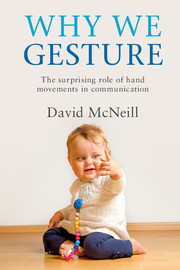6 - Phylogenesis
from Part II - Phylogenesis, ontogenesis, brain
Published online by Cambridge University Press: 05 December 2015
Summary
How language began provides the ultimate explanation of gesture–speech unity, the final answer to why we gesture, its dynamic dimension, that gesture is an integral part of language, that language gives inhabitance and how gestures orchestrate speech.
Theories of the origin language differ but basically there are only three. Many today posit gesture-first, a language of gestures or signs that speech eventually emerged to supplant. In earlier years, the choice was speech-first, theories mentioned earlier and absurdly named bow-wow or yo-he-ho among others (speech evolving out of onomatopoeia or work-chants, M. Müller 1861). Speech-first is equally derailed by the arguments that undo gesture-first and I concentrate on the latter. Even though we are referring to events hundreds of thousands of years ago, origin theories can be tested. We ask: can the theory explain how gesture–speech unity evolved? Also, can it explain speech–gesture synchrony? If it cannot, that is one kind of falsification. Does it also positively predict that these things did not evolve? That is another kind. We shall see that gesture-first (and speech-first) fails both tests. The theory here takes the third position. It posits gesture–speech equiprimordiality (a term of art coined by Liesbet Quaeghebeur, personal communication). I propose later in the chapter a mechanism called “Mead's Loop” that assumes gesture and speech evolved jointly. Unlike gesture- or speech-first, it produces gesture–speech unity, dual semiosis, an imagery–language dialectic, psychological predicates absorbing context and gesture-orchestrated speech, and thus passes the tests they fail.
Gesture-first
The gesture-first theory, going back centuries (see Levelt 2013) and popular again today in many books and articles, says that the first steps toward language phylogenetically were not speech, nor speech with gesture, but were gestures alone. Vocalizations in non-human primates, the presumed precursors of speech without gesture's assistance, are too rigid and restricted in their functions to offer a plausible platform for language, but primate gestures appear to offer the desired flexibility. Thus, the argument goes, gestures could have been the linguistic launching pad (speech evolving later). The gestures in this theory are regarded as the mimicry of real actions. They are in fact “old” action-actions, a kind of pantomime, hence the appeal of mirror neurons as the mechanism (Rizzolatti and Arbib 1998).
- Type
- Chapter
- Information
- Why We GestureThe Surprising Role of Hand Movements in Communication, pp. 109 - 141Publisher: Cambridge University PressPrint publication year: 2015



